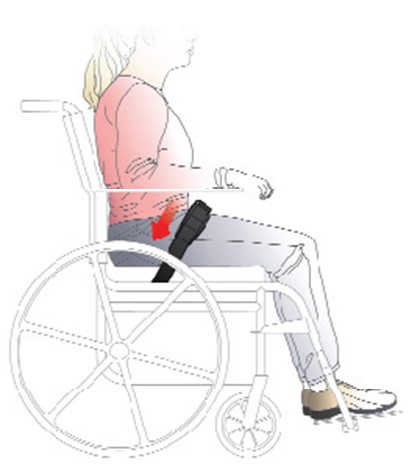Bread and Butter: Dynamic Backs and Pelvic Positioning Belts
Michelle L. Lange, OTR/L, ABDA, ATP/SMS
Updated 9/26/2022
Just like Bread and Butter, Dynamic Backs and Pelvic Positioning Belts go together. Dynamic Backs are designed to allow movement at the pelvis and torso in response to client force and then return the client to a neutral starting position. A key component is the pelvic positioning belt, which is designed to maintain the pelvis in as neutral a position as possible in relation to the seating system. When that seating system moves, the pelvic belt is even more critical in maintaining pelvic position.
The pelvis, without appropriate support, may move into a posterior pelvic tilt during movement of the Dynamic Back. The best angle of the pelvic belt to limit posterior pelvic tilt is approximately 60 degrees. The Seating Dynamics Dynamic Rocker Back interface is designed to return the client to upright sitting without loss of posture using a raised pivot point. However, a pelvic belt is still required.
Now there are some settings in which a pelvic belt is misconstrued as a restraint. A positioning device is designed to maintain alignment with the primary support surfaces (the seat and back), provide stability and postural support, and to promote function. A restraint is intended to limit movement to protect the client and/or others. Dynamic Seating is about movement, not restraint! So what should you do if you are working with someone who needs a Dynamic Back, but also needs a pelvic positioning belt in order to maintain a neutral pelvis?
When working in an environment where restraint guidelines are used, documentation must justify the clinical indicators for each seating component. Most regulations look at the intent of the component to determine whether this is being used as a restraint. For example, a clinical indicator may be “a pelvic positioning belt is being recommended to maintain a neutral pelvic position which, in turn, will facilitate a more upright trunk and head position.” If your setting continues to question these recommendations, review pertinent definitions, regulations and policies. Find out what your settings-specific requirements are. Does the facility use OBRA regulations or other definitions? Are these regulations the most current? Have these been modified?
For further information, we have included the following documents on our Downloadable Resources page:

